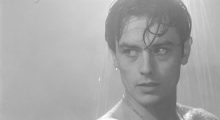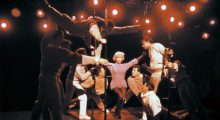Filmmaking
Filmmaking
-
Promise and The Pitch: A Bible-Themed Short Film Contest That Offers $40,000 in Production Financing

Director and film critic Neville Pierce, who we interviewed several months ago around the online premiere of his shorts, has a new film, Promise, up on the interwebs, and it’s tied to the announcement of an unusual short film contest that offers filmmakers $40,000 in production funds for their winning pitch. From the press release: The Pitch is an annual online pitching competition which invites filmmakers to submit a two-minute video pitching their idea for a short film inspired by The Bible. It can be in any genre, can emerge from any perspective, and can draw on any story, passage, […]
-
Kickstarting a “Mezuzah Movie”: Gerald Peary on The Rabbi Goes West

What’s a non-religious, non-observant Jew doing making a movie called The Rabbi Goes West, in which the main character is a Torah-following Hasidic Orthodox rabbi? And who is now, between beloved corned beef sandwiches, in the middle of a $40,000 Kickstarter campaign through August 10 to finish it? Click here to go our Kickstarter page. Glad you asked. I’m a long-time film critic (The Boston Phoenix) and one-time actor (Computer Chess) who turned to filmmaking (For The Love of Movies: the Story of American Film Criticism). My last documentary, Archie’s Betty, was appreciated by the thousand people who saw it, […]
-
Towards Gender-Blind Casting: Conversion Therapist Writer/Director Bears Fonte on Trans Performers

On June 12th, 2016, I woke up to coverage of the Pulse nightclub shooting and felt my heart being ripped out. Even worse, I was due to moderate a Q&A of the Sandy Hook shooting documentary Newtown that night. What world were we living in? In the aftermath of Pulse, I couldn’t believe the bigotry of certain “ministers” who did more than hint that they believed the terrorist had done the world a favor. Roger Jimenez, a Sacramento preacher, said in a sermon to his parishioners, “The tragedy is that more of them didn’t die… I’m kind of upset that he […]
-
Be Everywhere All At Once: The Ultimate Guide to Festivals, Online, & Your Short Film Release

The following article is crossposted with, Short of the Week, a new kind of film festival aimed at discovering the next wave of emerging filmmakers crafting stories for online audiences. Visit them at shortoftheweek.com A few years ago we released our short film online and shared the tactics behind the strategy we used to get views and industry attention in one of our most popular articles titled How We Launched Our Film Online. In the years since, we’ve had the pleasure of working with thousands of filmmakers to release their short films to millions of people around the world and […]
-
A Sense of Place: The Job of the Location Manager

The following article appeared in Filmmaker’s Spring, 2018 print issue. Like many departments on a film set, the locations department has duties that are a mixture of artistic and practical, a blend of orchestrating creative epiphanies and managing tedious logistics. Location managers might jaunt off to explore tropical beaches or spend the day sharing their favorite secret enclave of New York with an esteemed director, but they also might toil for weeks figuring out where the crew will park, eat and go to the bathroom. And if you’ve ever worked on a low-budget movie without the cash for a fancy […]
-
Rocco and His Brothers, Dietrich and Von Sternberg, and Dragon Inn: Jim Hemphill’s Weekend Viewing Recommendations

One of the most important restorations of the last few years makes its way to Blu-ray this week with Milestone’s exquisite release of Luchino Visconti’s Rocco and His Brothers (1960). A brutally realistic, emotionally charged family saga that flies by in three of the most involving hours ever put on film, Rocco and His Brothers is an extraordinary combination of Visconti’s neorealist side (previously seen in Ossessione and La Terra Trema) and the operatic, ambitious tendency toward tumultuous historical change and penetrating social commentary that characterizes later masterpieces like The Leopard and The Damned. The film follows the brothers of […]
-
“Don’t Sell Out, Don’t Give Your Art to a Corporation”: Secrets of DIY Doc Distribution at DOC NYC PRO

There are many reasons filmmakers might choose to self-distribute their documentaries: they may want residuals to come in throughout their careers, as opposed to what might be just a single upfront payment in an all-rights deal; they may feel a responsibility to their audience or subject matter to shepherd the project and not sell it off to a distributor focused on the bottom line; or maybe no one is knocking down their doors to buy your movie. At the recent DOC NYC PRO Distribution Book Camp, four filmmakers who have self-distributed projects (which can mean they are still self-distributing those […]
-
Toy Story and Little Miss Sunshine Screenwriter Michael Arndt on How to Craft Good Beginnings and Endings

As with life, beginnings are easy but endings are hard. At least, that’s what one might take away from the two very different running times of videos screenwriter Michael Arndt (Toy Story, Little Miss Sunshine) has posted about these crucial elements of any movie. His “beginnings video” runs eight minutes while his video on endings has a whopping feature-length running time! Using three films as his examples — Star Wars, The Graduate and Little Miss Sunshine — Arndt talks about internal and external conflict, philosophical resolutions and much, much more. As the screengrab above illustrates, Arndt is heavy into structure, […]
-
Lubitsch, Cukor and Quine: Jim Hemphill’s Weekend Viewing (and Reading) Picks

I once took a class with the late, great silent film historian David Shepard, who introduced a screening of Ernst Lubitsch’s The Student Prince in Old Heidelberg by saying, “Watch closely. You can learn how to make movies from this man.” An hour and forty-five minutes later I understood what he meant; every composition, cut, and camera movement was purposefully and powerfully designed to convey the characters’ emotional states in ways that were clear and simple yet opened the film up to multiple interpretations and nuances. Yet there’s always been something just a touch ineffable about Lubitsch’s style and how […]
-
Three Interviews with Gus Van Sant About his Long-Take, Béla Tarr-Influenced “Death Trilogy”

With a Gus Van Sant retrospective currently playing at New York’s Metrograph Cinema until July 12, we’ve reposted the three interviews we did with the director for his celebrated “death trilogy.” Comprised of Gerry, Elephant and Last Days, these three films — all based on actual news reports, dealing with mortality and shot in a long-take style influenced by directors such as Béla Tarr and Chantal Akerman — constitute one of cinema’s most audacious, radical and rewarding change-ups from a director who has had at least one foot in mainstream cinema. All three films are part of the Metrograph series, […]










